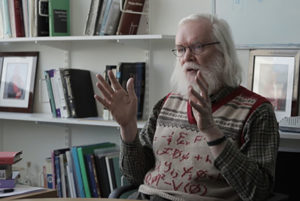The Stability of the Solar System
Institute for Advanced Study Prof. Scott Tremaine on the universal law of gravity, predictability and chaos in...
How does chemical analysis help scientists determine the age of a star? How do gases behave in early stars? What can a mass of a star tell us about its transformations? These and other questions are answered by Christopher McKee, Professor Emeritus of Physics and Astronomy, University of California, Berkeley.
Primordial stars are one of the most interesting topics in astrophysics. We have never seen a primordial star. So the field is driven almost entirely by theory. … So the first issue is, what are the key differences between primordial stars and the stars that are forming today. There are two main differences. The first one is that primordial stars do not have any heavy elements, such as carbon, nitrogen, oxygen that they are made of and are all created in the interiors of stars. …So you are talking about a star formation that is occurring in hydrogen and helium, there’s a trace amount of lithium but that is so small that it really doesn’t have an effect. The second difference is that whereas star formation today occurs when the gas in the interstellar medium accumulates enough, so that it can undergo gravitational collapse, in the very beginning it turns out that the gas was actually very smoothly distributed, and it was in the dark matter which has about four times more mass than the baryons do, it was the gravitational potential wells in the dark matter that ceded the first stars.
So a key question is, what is the mass of a primordial star? This is important for two reasons. First of all, if the primordial stars had a very broad distribution of masses, such as contemporary stars do, and in particular, if the primordial stars extended down the masses less than the eight tenths of the mass of the Sun, then such stars would have been able to survive all the way after they were formed, shortly after the Big Bang, till today, and we could see them. We would actually be able to see a low-mass star that had no metals in it at all. No such stars have been seen. So apparently, they were more massive than that.
How is it that we can try and learn about this today, as this all happened over 13 billion years ago? There’s an observational clue, and this field has been dubbed as stellar archeology – looking for very very old stars, not the first stars as these stars were formed with no heavy elements, but looking at the second generation of stars. Those stars actually incorporated the heavy elements that were made in the first stars. As I described, we can tell or refer what the mass of those first stars was from the pattern of heavy elements that are produced. Astronomers are doing very large surveys of hundreds of thousands of stars looking for those stars that have a very little metal abundance.

Institute for Advanced Study Prof. Scott Tremaine on the universal law of gravity, predictability and chaos in...

Computer Scientist José Luis Vázquez-Poletti on the Mars MetNet Mission, using public cloud computing for spac...

Physicist John Ellis on what the Higgs boson is and the history of its discovery